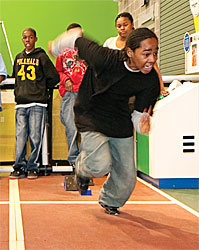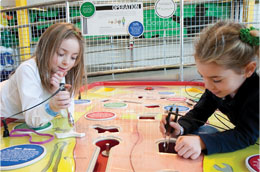Spring 2010
 |
||
Photo: John Altdorfer |
Run, bounce, spin, climb—and learn!
By Niki Kapsambelis Timothy Robinson holds the secret to flying: By using his upper-body strength to yank down on a cable attached to a three-foot flywheel, he’s able to shoot himself to the top of a 24-foot-high arch, where he dangles from a set of handlebars before slowly descending and starting again.“When you come down, get down on your knees and push off a little, and you’ll go higher,” advises the 14-year-old, breathlessly, having mastered the physics of the You-Yo, a featured exhibit of the new Highmark SportsWorks® at Carnegie Science Center. The You-Yo, one of only nine such devices in the world, is one of 11 new interactive experiences designed to get the adrenaline pumping inside the recently reopened science-of-sports attraction, and it immediately proved to be a crowd favorite. It teaches how physics, the transfer of energy, and rotational pull combine to turn each rider into the human equivalent of a classic Duncan Imperial yo-yo, propelling them higher with each turn. “It’s essentially Newton in a box: gravity, inertia, and momentum,” explains Dennis Bateman, director of exhibit experience at the Science Center, who coordinated the design and construction of Highmark SportsWorks®. Photos: John Altdorfer For Robinson, who rode the You-Yo not once, but twice, it was a fun ride—but still a half-step behind his favorite exhibit, Coaster Physics, a full-motion, 360-degree flight simulator that he hopped on four times and rated a nine out of 10 for thrills. For Robinson, who rode the You-Yo not once, but twice, it was a fun ride—but still a half-step behind his favorite exhibit, Coaster Physics, a full-motion, 360-degree flight simulator that he hopped on four times and rated a nine out of 10 for thrills. “If you’re squeamish, don’t go on it. That Steel Phantom will get to you,” he warns, referring to one of the simulated tracks, which is a replica of Kennywood Park’s Steel Phantom roller coaster. (The exhibit features the original sign that hung at the entrance to the real Steel Phantom before it was redesigned several years ago and christened the Phantom’s Revenge.) Coaster Physics is a returning favorite from the original SportsWorks, which closed in August 2008, seven years and 3 million visitors after it was built, to make way for the extension of the North Shore light-rail station. Its successor, debuting this past December, is a $5 million, 12,000-square-foot attraction in a new building adjacent to the main Science Center building. It features nearly 30 hands- and body-on experiences designed to challenge, thrill, and teach the science behind sports and healthy living. Counting calories and thrillsThe original SportsWorks, housed in the home of the former Miller Printing Co. across the street from the main Science Center building, was always intended to be a temporary placeholder for the current attraction. The idea behind SportsWorks, then and now, is simple, says Ron Baillie, co-director of the Science Center. “This is a big sports town,” he explains. “And we know that a passion for sports can be used as a gateway into the topics of physics, anatomy, biology, chemistry—and perhaps even inspire young people to seek careers in science-related fields.” “Part of our mission is making science applicable to everyday life.”- Dennis Bateman, director of exhibit experience
Highmark SportsWorks® is themed around three general topics: Sports Challenge; The Physics of Sports, which demonstrates the hands-on application of scientific principles, the You-Yo being a prime example; and LifeWorks, which stresses the benefits of staying healthy and embracing an active lifestyle, something that’s been enhanced through the Science Center’s partnership with local insurance giant Highmark.  “These are hands-on exhibits that are presented in a fun, high-tech, interactive format,” says Ann Metzger, co-director of the Science Center. “These are hands-on exhibits that are presented in a fun, high-tech, interactive format,” says Ann Metzger, co-director of the Science Center.Visitors who try the Calorie Cycle, for example, can choose different snacks and then pedal a hand cycle to find out how long it will take to burn off a chocolate bar versus, say, baby carrots. They can also test their cardio fitness in a stair-stepping activity and view a monitor showing an electrocardiogram and a simulation of their heart beating. Each exhibit, regardless of topic, includes a calorie counter that explains how much burn the user is getting for the buck. Adults jumping on Bounce!, which rigs them to bungee cords, allowing them to springboard from a trampoline, will burn 240 calories an hour. But bad news for the coaster fanatics: Riding the simulator burns just 100 calories an hour, an amount so paltry that the exhibit sign notes, “It’s important to get at least 30 to 60 minutes of real activity each day.” Of course that didn’t stop children from lining up outside the simulator for multiple rides on virtual tracks. Repeat rider Marquies Anger, 14, was there for the rush: “It was scary when you go upside down a bunch of times. It felt like you were about to just hit something.” The science behind the gameThe new attraction, like its predecessor, sparks lots of science-related questions—and observations—from kids of all ages. “The roller coaster simulator is a great way to demonstrate physics,” says Sean McGrath, 14. “It really synched up with all the movements.” McGrath, who hopes to one day become an engineer, tested his skill on Reaction Time Hockey, which requires players to press hockey pucks with their hands as they light up in random order. As the exhibit explains, the average person’s reaction time is 0.2 seconds, but a good hockey goalie is about 25 percent faster, at 0.15 seconds. But McGrath, who plays forward on a Pittsburgh youth hockey team, was skeptical about how closely the exhibit mimicked the real thing.  “Goalies see the puck coming in, so they have more time to react,” he says. “If they’re taking a slap shot from the point, you have to come out and play the angles.” He was more impressed with the tips offered at the pitching cage, which, among other things, explain why it’s important to warm up before baseball games. The cage, another returning favorite, falls under the category of a Sports Challenge and allows visitors to be part of the game. Would-be pitchers measure their speed with a radar gun, and also find out why it’s important to stretch muscles to avoid injury and why pitching a curveball is impossible in outer space (because the ball needs air to make its path bend). Jamie Townsend, 27, of Dayton, Pennsylvania, tested her pitching mettle against that of her 11-year-old nephew, River Schindledecker. River triumphed, barely, at 45 mph, edging out his aunt, who threw 44 mph. Townsend had not been to SportsWorks since she was in school herself, but returned with family members to help supervise six children ranging in age from 6 to 13. Despite the age disparity, “they’re very occupied,” she said, as her 6-year-old son, Hunter, flipped 360 degrees on Bounce! “It’s safe enough that they can run from exhibit to exhibit. There’s plenty for the whole family to do—kids and parents.” Healthy living: a lifelong lessonEntering the building on the second floor, where the building’s classrooms are located, visitors are greeted with a panoramic view of the action-packed gallery below. From the entry point, the adventurous can board the High Cycle, a unicycle that crosses a beam above the gallery, or simply descend a ramp to the gallery below. Staff, of course, help relay the science behind the fun. Aaron Stein, one of two staff members working at Bounce! on a cold winter afternoon, coaxed a reluctant middle-school-aged girl onto a scale so he could figure out how much resistance to put on the bungee cord attached to her harness. “It doesn’t tell us your weight in pounds,” he explains. “It’s a special scale.” Colors on the scale, he continues, tell him the perfect number of bungee bands to attach to the harness, and then, by adjusting the tension, he helps provide a good bounce on the trampoline. Some riders are able to flip completely around, he noted. “Do you have to flip?” asks 14-year-old Jasmine Ion, sounding somewhat nervous. “You don’t have to flip if you don’t want to, no,” answers Stein. But despite her reluctance, Ion did make an unsuccessful attempt at a flip before her turn was over. For students who attend Highmark SportsWorks® on field trips, the Science Center provides teachers with downloadable education guides so they can discuss the concepts in advance. And each exhibit features small takeaway tips, such as why it’s important to wear a helmet while skateboarding, or understanding breath capacity and heart rate. “We know that if healthy behaviors are instilled in children early in life, they stay with them forever,” says Highmark President and Chief Executive Officer Ken Melani, noting that Highmark SportsWorks® was designed to support Pennsylvania’s academic standards for schools in health as well as science and technology. Visitors can also learn about potential careers in fields relevant to the exhibits, such as nutrition or radiology. “Part of our mission is making science applicable to everyday life,” says exhibit experience director Dennis Bateman. “Especially with the dismal predictions about the health of our youth, we’re trying to literally jog them into a more active lifestyle.” New thrills at Highmark SportsWorks®The new and improved Highmark SportsWorks® offers a combination of new exhibits and old favorites. Check out the latest additions:You-Yo A 24-foot-high arch topped by a 3-foot flywheel allows visitors to use kinetic energy to turn themselves into human yo-yos and fly high into the air. Calorie Cycle Visitors choose different snacks and compare how long it takes to burn off the calories of each while pedaling a hand cycle. Drugs in Sports Three interlocking gears demonstrate how various illegal sports drugs affect the body. Chomp! Video technology allows multiple players to compete in a game to chase down a healthy diet. BodyScan Touch-screen technology reveals the insides of the human body as seen through X-ray, CT, and MRI scans. ECG Staircase Tests cardio fitness in a stair-stepping activity with an ECG monitor. Valve Challenge Pump blood through a simulated leg and see how blood flows against the force of gravity. Joints Table Experiment with different joints found in the body and compare them to artificial counterparts. BodyCam This simulator ride explores cutting-edge surgical techniques. Reaction Time Hockey Test your reaction time with a Whack-A-Mole-style game adapted to a goalie’s net. Sports Injuries Operation Game Using an oversized OPERATION game, remove and repair body parts linked to the 10 most common sports injuries. |
|
Also in this issue:
I Just Want to Watch · The Next 15 · Regenerative Medicine: A Growing Future · President's Note · NewsWorthy · Face Time: Heather White · Science & Nature: Our Super-sized World · Artistic License · About Town: Asking Andy · The Big Picture
 |
Copyright © 2017 CARNEGIE Magazine. All rights reserved. |

 Carnegie Science Center’s Highmark SportsWorks® is back and better than ever—with plenty of energizing lessons about the science of sports, nutrition, and healthy living.
Carnegie Science Center’s Highmark SportsWorks® is back and better than ever—with plenty of energizing lessons about the science of sports, nutrition, and healthy living.